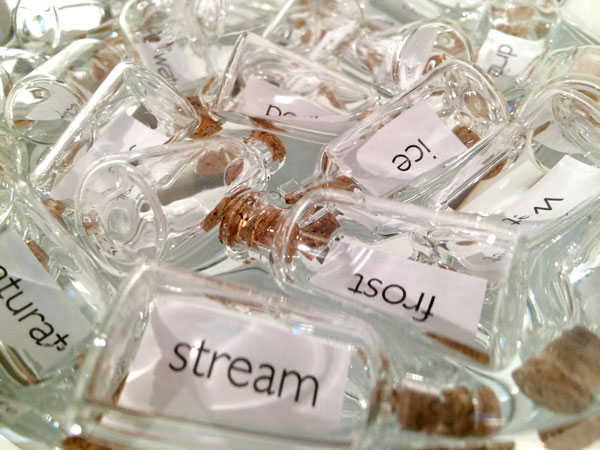Sant Khalsa isn’t reticent about her artistic influences. In artist statements, she points to the photographs of Walker Evans, Ed Ruscha, and the Bechers as impactful on her own practice of photographing landscapes of the Southwest, particularly those of Southern California. Indeed, her photographs’ social documentary style, their stark black-and-white color scheme, and their display in serial and grid formations readily conjure up such allusions. As the accompanying exhibition to her residency at Pasadena City College reveals, however, Khalsa’s work is far from derivative; it intertwines the spiritual and the quotidian, the specific and the universal, and unites wit with profundity.
Khalsa is a longtime resident of San Bernardino, a suburb in the Inland Empire desert. In her “Paving Paradise” series, she photographs the Santa Ana River, which snakes through the region and provides both sustenance and, occasionally, destruction and disappointment. The images include flooded houses, parched swathes of land, and flowing rivulets; all are devoid of explicit human presence, but Khalsa’s shadow, a brittle and discarded Christmas tree, and stark fences allude to humans’ both benign and deleterious impact upon their environment. Fellow Inland Empire denizen John Divola’s work comes to mind here as well, especially his “Isolated Houses” series in which the absence of humans is made more manifest by the presence of their empty structures.
In “Trees and Seedlings” Khalsa moves beyond documentation of the specific site of the Southern California desert to sculptural objects that reference cycles of life and death and the ephemerality of nature. The pieces are wood planks that vary in height, with a cutout in which a transparent photographic image of ravaged and charred trees is held between glass sheets. Attenuated and anthropomorphic like a Giacometti sculpture, these delicate pieces convey loss and mourning.
Perhaps the most beguiling piece is Pray for Rain (Prayer Wheel) (2015), a glass cylinder atop a plinth, filled with 28 small corked bottles with messages referring to water written inside them. A blue blown-glass orb sits atop the cylinder, and a motor turns the messages clockwise like a traditional Tibetan Prayer Wheel. In its uniting of the mechanical and the magical, the piece initially seems amusing, but recalling the dire straits of California during its drought encourages more sober contemplation of the work’s intent.
Khalsa’s largest series on display is a selection from “Western Waters”, in which she again engages with the Southwest and its precarious reliance on water. The series consists of straightforward photographs of the storefronts of small businesses catering to the commodification of this basic human need. Using words like “Pure,” “Cool,” “Perfect,” and “Crystal Clear,” these shops tap into fears of drought and contamination in their uniting of desire and survival. They perpetuate a false sense of abundance and are thus dangerous even as they provide economic security for their owners and sustenance to their patrons.
Khalsa has worked on some of these series for decades, but they take on a new relevance and urgency in light of California’s drought crisis.




















0 Comments